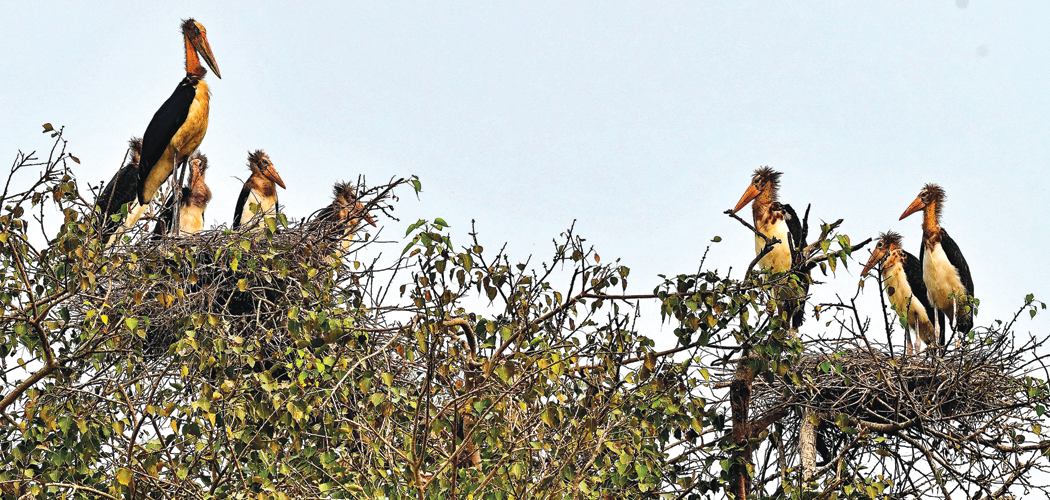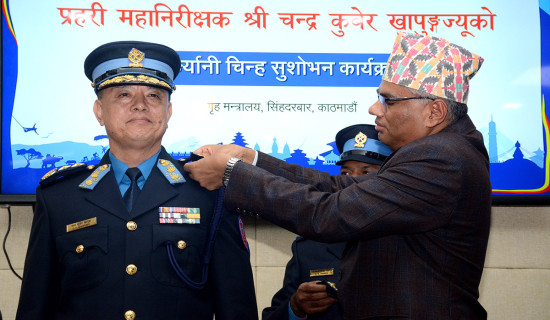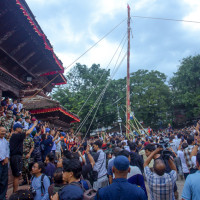- Friday, 5 September 2025
A bird That Feeds On Snakes
Rajesh Dhungana
The famous Jagdishpur Lake of Kapilbastu district is a haven for migratory birds. I had gone there for two days during the winter season to take pictures of migratory birds in this popular wetland area (Jagadishpur Lake).
Wetland Habitat
While walking around the wetland area, I saw a lot of lesser adjutants, known in the Nepali language as Bhundifor Garud. There were 3 to 4 nests on the top of a tree with these birds. There were seven nests on two trees. I went to Tulihawa for two days to take different pictures of this bird and stayed there for 11 days, especially for taking pictures of this bird. Daily, I used to go to the Burmeli Tole area, situated near Jagdishpur Lake, in the morning to take pictures of this bird and return to Taulihawa in the evening. At the same time, I was able to take pictures of different species of birds.
According to what I know, the main food of Bhudifor Garud is a snake. It roams around ponds, ponds, fields, etc. in search of snakes. When it cannot find snakes, then it feeds on fish, frogs, large invertebrates, rats, mammals etc. It was during this time that migratory birds and other species visited the Niklisagar lake of Niglihawa in the Kapilvastu district. Birds of this species, Lesser Adjutant (Bhundifor Garuda), are also seen there.
While walking around the Jagadispur wetland area, I saw a lot of these species of birds. But what struck me was a bird that was in search of a snake in the lake. After a while, the bird found a large snake and swallowed all of it in about two minutes. The scene was very interesting and I managed to take pictures of this event.
After swallowing the snake, the bird flew out of the lake. I suspected that this snake must have gone to its nests to feed its chicks. The bird flew away from here after eating a snake in the lake of Niglihawa. Since the Burmeli Tole road is close to Niglihawa Lake, the locals called me after some time and told me about birds carrying snakes and feeding the chicks. I was very curious.

If I could take this picture, my story would be very good. Thinking that I must take a picture of the bird with its chick while it feeds the chick, I went to the area in the afternoon. Since the bird's nest was at the top of the tall Simal tree, it was difficult to shoot the picture. However, When I was sitting some distance away, the mother bird had fed the snakes to the baby. But I could also manage to take a picture of the little chick vomiting as it could not swallow the snake.
This bird makes a nest on the top of a tall tree so that the chicks are not attacked by predators while it can have a close look at them from distance. This bird is particularly fond of the tall Bombyax Seiba and Karam (Adina Cardifoliyar) trees. These birds often nest near human settlements. The nest of this bird is more than one meter in diameter and about 1 meter deep.
In Nepal, the bird starts nesting in mid-September and lays its eggs within 28 to 30 days. By the end of January, all the chicks are ready to fly. The length of this bird is 34 to 27 inches. It weighs 4 to 5.71 kg. The bird is 43 inches to 47 inches tall. During the breeding season, the bird's face is red and its neck is orange. It enjoys fluttering its wings during sunrise and sunset. The wingspan is between 22.6 inches and 26 inches. This bird is also becoming rare and is listed in the MCN Red Data Book. Most of these species of birds can be seen in Kapilvastu, Rupandehi, Nawalparasi, Koshi Tappu Wildlife Sanctuary, Chitwan National Park, Vesagari Lake, Neelsagar Lake, Bardia National Park, Ghodaghodi Lake, Shuklaphanta National Park. Cambodia has the largest population of this bird. This bird is very rare in South India.
The scientific name of this bird is Leptoptilos javanicus. Lesser Adjutant is one of the eight endangered species in Nepal. During my 11-day stay in Taulihawa, the baby birds of this species were already flying. Most of the chicks I went to see were blown away. Only a few offspring were in the nest.
According to Hindu religious tradition, this eagle bird is considered to be the vehicle of the Hindu deity, Lord Bishnu. Most of the time, a statue of this bird is placed in front of the temple of Lord Vishnu. Devotees worship the same.
According to Devmala Bansali, the eagle bird was brought directly from the famous Changunarayan temple in Bhaktapur. Therefore, in the place where Changunarayan's Gajur is seen, even the bite of a snake or a serpent is believed to have no poisonous effect.
Declining
According to Lalit Gurung, chairman of the Jagdishpur Reservoir Multi-stakeholder Forum of Jagdishpur Lake, the bird has been living in the area for 15 to 20 years. In the last few years, the number has decreased due to the felling of tall trees, noise pollution and deforestation.
This multi-stakeholder forum has been carrying out public awareness work for the protection of this bird and for the protection of the guest birds coming to Jagdishpur Lake from time to time. It is the responsibility of all of us to protect the lake and birds.
According to Khadananda Paudel, Programme Development Manager, Bird Conservation Nepal, the Lesser Adjutant bird worldwide is deteriorating. The number of these birds in the world is from 5500 to 10000, while the number of these birds in Nepal is estimated from 300 to 1000. It is found mainly in Bangladesh, Bhutan, Brunei, Cambodia, China (Mainland), India, Indonesia, Laos, Malaysia, Myanmar and Nepal. The bird's habitat is farms, wetland areas and forest areas. The main reasons for the sharp decline in the number of birds are the use of excessive pesticides in agriculture, hunting and poaching due to lack of public awareness, and damage to the bird's nest when large trees are uprooted.
(Dhungana is a former photo editor of Gorkhapatra Daily, currently involved in wildlife Photography. All photos by writer)
















